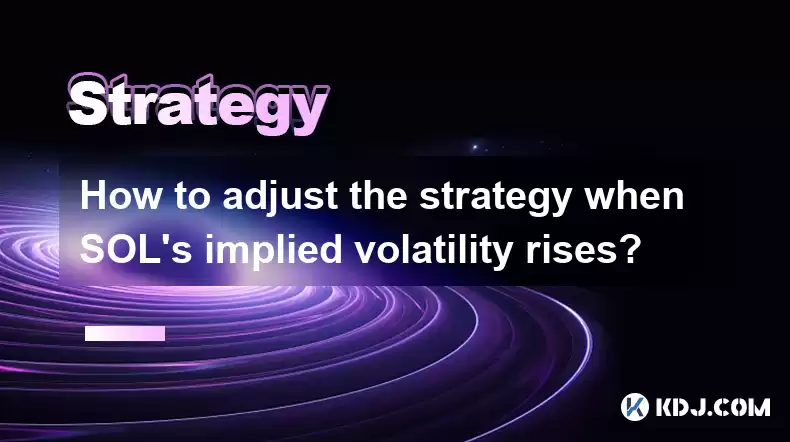-
 bitcoin
bitcoin $110918.433029 USD
-1.69% -
 ethereum
ethereum $3996.872473 USD
-2.43% -
 tether
tether $1.000594 USD
0.00% -
 bnb
bnb $1178.871834 USD
-2.38% -
 xrp
xrp $2.413973 USD
-3.47% -
 solana
solana $194.341461 USD
-4.24% -
 usd-coin
usd-coin $0.999963 USD
-0.03% -
 tron
tron $0.320092 USD
0.92% -
 dogecoin
dogecoin $0.196919 USD
-3.42% -
 cardano
cardano $0.669585 USD
-3.63% -
 hyperliquid
hyperliquid $37.485952 USD
-3.58% -
 ethena-usde
ethena-usde $1.000026 USD
-0.02% -
 chainlink
chainlink $18.018220 USD
-5.13% -
 bitcoin-cash
bitcoin-cash $523.879267 USD
-2.41% -
 stellar
stellar $0.324655 USD
-3.67%
How to adjust the strategy when SOL's implied volatility rises?
When Solana's implied volatility rises, traders should consider buying straddles or selling options, while investors might reallocate assets or diversify to manage increased risk.
Apr 27, 2025 at 11:35 am

When the implied volatility (IV) of Solana (SOL) rises, it's crucial for traders and investors to adapt their strategies to manage risk and potentially capitalize on the increased market movements. Implied volatility is a metric that reflects the market's expectation of a cryptocurrency's future volatility, derived from the prices of options contracts. A rise in SOL's IV indicates that the market anticipates larger price swings in the near future, which can affect both trading and investment decisions.
Understanding Implied Volatility and Its Impact on SOL
Implied volatility is a forward-looking indicator, unlike historical volatility, which measures past price movements. When SOL's IV rises, it suggests that option traders are expecting significant price changes. This can be due to upcoming events, market sentiment shifts, or broader economic factors. Understanding this metric is vital because it influences the pricing of options, making them more expensive when IV is high. For traders, this means that buying options becomes costlier, while selling options can be more profitable but riskier.
Adjusting Trading Strategies with Rising IV
When SOL's IV increases, traders need to adjust their strategies to align with the new market conditions. Here are some approaches to consider:
Buying Straddles or Strangles: These strategies involve buying both a call and a put option with the same expiration date but different strike prices. A straddle uses the same strike price, while a strangle uses different ones. These strategies can be profitable if SOL's price moves significantly in either direction, which is more likely when IV is high.
Selling Options: With higher premiums due to increased IV, selling options can be lucrative. However, this strategy carries significant risk as the potential for large price swings increases the likelihood of the options being exercised. Traders might consider selling options that are out-of-the-money to mitigate some of this risk.
Delta Hedging: This involves adjusting the position in the underlying asset (SOL) to offset the delta of an options position. When IV rises, delta values can change more rapidly, requiring more frequent adjustments to maintain a neutral position.
Adjusting Investment Strategies with Rising IV
For long-term investors, a rise in SOL's IV can signal a need to reassess their portfolio's risk exposure. Here are some adjustments to consider:
Reallocating Assets: Investors might reduce their exposure to SOL or hedge their positions with options or other cryptocurrencies. This can help manage the increased risk associated with higher volatility.
Diversification: Increasing the diversity of the cryptocurrency portfolio can help mitigate the impact of SOL's volatility. This might involve investing in other cryptocurrencies with lower IV or different market correlations.
Long-Term Options: Purchasing long-dated options can be a strategy to gain exposure to SOL while limiting downside risk. These options are less sensitive to short-term IV changes but can still benefit from long-term price movements.
Managing Risk with Rising IV
Risk management becomes even more critical when SOL's IV rises. Here are some key practices:
Stop-Loss Orders: Setting stop-loss orders can help limit potential losses if SOL's price moves against your position. However, in highly volatile markets, stop-losses might be triggered more frequently.
Position Sizing: Reducing the size of positions can help manage risk. Smaller positions mean less exposure to potential adverse price movements.
Monitoring IV Levels: Keeping a close eye on IV levels can help traders and investors anticipate when adjustments might be needed. Tools like volatility charts and option pricing models can be invaluable in this regard.
Technical Analysis and IV
Technical analysis can provide additional insights when SOL's IV rises. Traders might look at the following:
Bollinger Bands: These can expand with increased volatility, providing visual cues about potential price breakouts or reversals.
Moving Averages: These can help smooth out price data and highlight trends, which might be more pronounced during periods of high IV.
Volume Analysis: Higher trading volumes often accompany increased volatility, and analyzing these can help traders understand market sentiment.
Practical Steps to Implement Strategy Adjustments
Here are practical steps to adjust your strategy when SOL's IV rises:
Assess Current Positions: Review your current holdings in SOL and related options. Determine how a rise in IV might impact these positions.
Choose a Strategy: Decide on a strategy based on your risk tolerance and market outlook. This might involve buying straddles, selling options, or adjusting your investment portfolio.
Execute Trades: Use a reputable trading platform to execute your chosen strategy. Ensure you understand the fees and risks associated with each trade.
Monitor and Adjust: Continuously monitor SOL's price and IV levels. Be prepared to adjust your strategy as market conditions change. This might involve closing positions, opening new ones, or rebalancing your portfolio.
Keep Records: Maintain detailed records of your trades and strategy adjustments. This can help you learn from past decisions and refine your approach over time.
Frequently Asked Questions
Q: How can I predict when SOL's IV will rise?A: Predicting IV changes can be challenging, but you can look for signs such as upcoming events (like protocol upgrades or regulatory announcements), shifts in market sentiment, and broader economic indicators. Monitoring option pricing and volatility charts can also provide clues.
Q: What are the risks of selling options when SOL's IV is high?A: Selling options when IV is high can be profitable due to higher premiums, but it also increases the risk of the options being exercised. If SOL's price moves significantly, you could face substantial losses, especially if you're selling naked options without a hedge.
Q: Can I use IV to gauge the overall market sentiment for SOL?A: Yes, IV can be a useful indicator of market sentiment. High IV often reflects increased uncertainty or anticipation of significant price movements, while low IV might indicate a more stable or complacent market.
Q: How often should I adjust my strategy when SOL's IV is rising?A: The frequency of adjustments depends on your trading style and risk tolerance. Active traders might adjust their strategies daily or even intraday, while long-term investors might make adjustments less frequently, perhaps weekly or monthly, based on their overall portfolio strategy.
Disclaimer:info@kdj.com
The information provided is not trading advice. kdj.com does not assume any responsibility for any investments made based on the information provided in this article. Cryptocurrencies are highly volatile and it is highly recommended that you invest with caution after thorough research!
If you believe that the content used on this website infringes your copyright, please contact us immediately (info@kdj.com) and we will delete it promptly.
- DOGE, AlphaPepe, and the Crypto Explosion: What's Next?
- 2025-10-17 04:25:14
- Dogecoin, Bitcoin, and Ethereum: Navigating the Crypto Current
- 2025-10-17 04:25:14
- Dogecoin, Shiba Inu, and Remittix: Meme Coins vs. Real Utility
- 2025-10-17 05:05:14
- Toncoin's Next Move: Catalysts and Considerations for Investors
- 2025-10-17 05:05:14
- KGeN Token's Wild Ride: Price Surge, Plunge, and What It Means for Crypto
- 2025-10-17 05:10:01
- Coinbase, Altcoins, and DeepSnitch AI: Navigating the Crypto Landscape
- 2025-10-17 04:45:14
Related knowledge

Practical parameter settings for a Bitcoin multi-timeframe moving average system
Sep 18,2025 at 10:54pm
Optimizing Timeframe Combinations for Bitcoin Trading1. Selecting appropriate timeframes is crucial when building a multi-timeframe moving average sys...

How can I filter out false breakouts in Dogecoin high-frequency trading?
Sep 22,2025 at 01:00am
Understanding False Breakouts in Dogecoin Trading1. A false breakout occurs when Dogecoin's price appears to move beyond a defined support or resistan...

Techniques for identifying tops and bottoms in the Bitcoin on-chain NVT model
Sep 20,2025 at 07:54pm
Understanding the NVT Model in Bitcoin Analysis1. The Network Value to Transactions (NVT) ratio is often described as the 'P/E ratio' of the cryptocur...

What does the surge in open interest in Bitcoincoin futures mean?
Sep 20,2025 at 11:18pm
Understanding the Surge in Dogecoin Futures Open Interest1. A surge in open interest within Dogecoin futures indicates a growing number of active cont...

How can I use the Ethereum USDT premium to gauge market sentiment?
Sep 18,2025 at 11:55pm
Understanding the Ethereum USDT Premium1. The Ethereum USDT premium refers to the price difference between USDT (Tether) traded on Ethereum-based plat...

What should I do if Ethereum staking yields decline?
Sep 20,2025 at 06:18am
Understanding the Causes Behind Declining Ethereum Staking Yields1. The Ethereum network transitioned to a proof-of-stake consensus mechanism with the...

Practical parameter settings for a Bitcoin multi-timeframe moving average system
Sep 18,2025 at 10:54pm
Optimizing Timeframe Combinations for Bitcoin Trading1. Selecting appropriate timeframes is crucial when building a multi-timeframe moving average sys...

How can I filter out false breakouts in Dogecoin high-frequency trading?
Sep 22,2025 at 01:00am
Understanding False Breakouts in Dogecoin Trading1. A false breakout occurs when Dogecoin's price appears to move beyond a defined support or resistan...

Techniques for identifying tops and bottoms in the Bitcoin on-chain NVT model
Sep 20,2025 at 07:54pm
Understanding the NVT Model in Bitcoin Analysis1. The Network Value to Transactions (NVT) ratio is often described as the 'P/E ratio' of the cryptocur...

What does the surge in open interest in Bitcoincoin futures mean?
Sep 20,2025 at 11:18pm
Understanding the Surge in Dogecoin Futures Open Interest1. A surge in open interest within Dogecoin futures indicates a growing number of active cont...

How can I use the Ethereum USDT premium to gauge market sentiment?
Sep 18,2025 at 11:55pm
Understanding the Ethereum USDT Premium1. The Ethereum USDT premium refers to the price difference between USDT (Tether) traded on Ethereum-based plat...

What should I do if Ethereum staking yields decline?
Sep 20,2025 at 06:18am
Understanding the Causes Behind Declining Ethereum Staking Yields1. The Ethereum network transitioned to a proof-of-stake consensus mechanism with the...
See all articles










































































